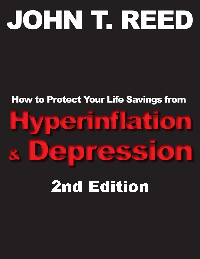Europe and Japan cut government spending, but not U.S.
by John T. Reed

 |
$34.95 |
We expect to start shipping on June 25, 2010.
Austerity measures everywhere but here
Page A11 of the June 23, 2010 Wall Street Journal has an interesting set of articles. Here are there headlines:
• France’s Lagarde [Finance Minister] Forecasts Austerity
• U.K. Unveils Severe “Unavoidable” Budget
• Japan Lays Groundwork for Cutting Massive Public Debt
Greece, Spain, Iceland, Ireland, and other European countries had previously announced various plans to cut government spending.
Have their U.S. counterparts—Obama, Geithner, Pelosi, Reid—announced any similar plans to cut federal spending?
Are you kidding? Their standing order is “full speed ahead” on more borrowing and spending, even though our deficit- and debt-to-GDP ratios already are worse than those of almost all the European countries that are enacting austerity programs.
What about the loyal opposition? Are the Republicans advocating spending cuts?
Are you kidding? They are terrified of doing so because Democrats would instantly burst out laughing at the Republicans for committing political suicide. Then they would make a zillion anti-Republican commercials saying the GOP was going to cut Social Security and Medicare, yadda yadda.
There are two Republicans in Congress who have advocated spending cuts: Paul Ryan (R-WI) and Eric Cantor (R-VA). But they are so unrepresentative of the Republican Party that the Dems rarely bother to tell the world those two are in favor of spending cuts.
If New Jersey governor Chris Christie were to announce he was running for president, U.S. bond interest rates would probably drop immediately. But he says he will not do that.
What does foreign austerity mean for U.S. bonds sale
In my new book How to Protect your Life Savings from Hyperinflation & Depression I said that I checked whether there were any countries that we should put our money in to avoid problems with the U.S. dollar. My research indicated there were not. Nowhere in the world. The other countries were all:
• in financial trouble themselves
• dependent upon the U.S. economy for their own economies
• used U.S. dollars as their reserves (a century ago they used gold for that purpose)
• worse at monstrous government spending
• had chronically high unemployment
But if Europe and Japan and other developed are really going to enact austerity programs, that is, cut their government spending, the equation changes. Most importantly, it changes for the world bond market.
The world bond market is very unhappy with U.S. government deficit spending. But, experts say, the world’s bond buyers“ have nowhere else to go”. The U.S. government bonds are the safest in the world so the world HAS TO buy them.
But what if other developed countries generally clean up their fiscal acts?
Then, a diversified portfolio of British Pounds, Euros, Swiss Francs, Yen, Canadian Dollars, Swedish Krona, and Australian Dollars starts to look as good as or even better than a dollar printed by a country that is bankrupting its government.
When the world bond market starts buying something other than U.S. bonds, U.S. bond interest rates will rise. We currently have a $13 trillion and climbing national debt. So every one percent increase in the interest we pay on that debt increases our deficit by 1% x $13 trillion = $130 billion per year.
If our federal budget is not already in a death spiral, multi-hundred billion dollar increases in our interest payments will put it there.
Eventually, the bond market stops buying the bonds. Then we will have the austerity program to end all austerity programs. At present, the only austerity program that would work if the bond market stopped buying our bonds would be our defaulting on our national debt and cutting government spending about 40%.
We spend $3.6 trillion on entitlements and operating the federal government this year and we only collect $2.1 trillion in taxes. If we cannot sell U.S. bonds, we can only spend what we take in in taxes. To fit our spending under the $2.1 trillion in tax revenues, we have to cut that $3.6 trillion down by about 40%—if we do it this year, more if we wait until future years. Every year we wait to act increases the percentage by which we have to cut federal spending. 

Hyperinflate our way out?
One suspects that our sleazy politicians will not cut spending if there is any other way. There is one: “printing” dollars to pay off maturing bonds and to pay bills like Social Security and Medicare.
That will cause hyperinflation. Hyperinflation causes the dollar to become worthless. One of the reasons the world bond market is complaining louder and louder about U.S. deficits is they know unaffordable debt tempts politicians to “print” money and thereby cause it to become worth less and ultimately worthless.
Unfortunately for cynical politicians, hyperinflation cannot last for more than a year or two because the public in the U.S. and around the world soon refuses to accept dollars as payment for goods or services. Plus rendering the dollar worthless bankrupts those who have large percentages of their net worth in the form of dollars or dollar-denominated assets like bank accounts, certificates of deposit, bonds, mortgages, and so on. Of course, all that causes the U.S. tax revenues to fall below the current $2.1 trillion.
Then, the default on the national debt and 50% (at that point) cuts in spending will take place because no other option will exist.
Other countries taking responsible action to cut their government spending brings that day closer. No wonder Obama is trying to persuade the countries adopting austerity programs to stop doing that and do more deficit busting stimulus programs instead.
John T. Reed